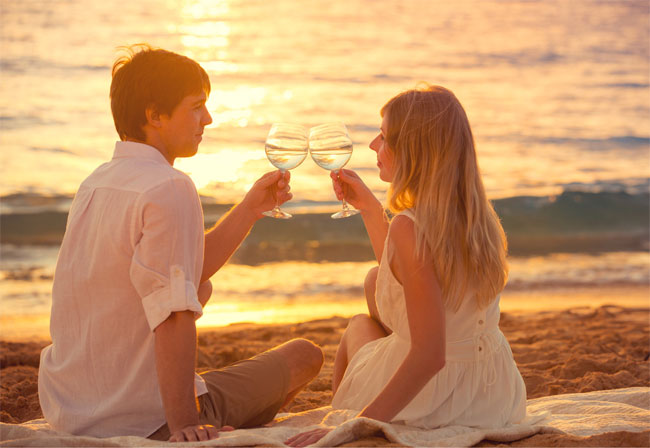Origin and interesting stories about honeymooners
Honeymoon comes from an old English word called "Honymoone" . Hony is associated with honey referring to the "joyful and tender stage of a newly married couple" and the sweetness of the early stages of marriage. Meanwhile, Moone refers to the time when the sweetness lasts. Honeymoon translated into Vietnamese as "honeymoon". The week here is not the week (7 days) as we often understand but the moon (a moon) - one round of the Moon is 1 month about 30 days.

Honneymoon is the dream of many newlyweds
Interesting stories about the origin of the honeymoon
Once upon a time, there was a sweet wine made from honey called mead (honey wine) and a honeymoon from an ancient custom related to this drink. Rumor has it that, in the old days, newcomer couples each drink a drink containing honey during the first 30 days - a month (a moon - that's why one month later they call it a month) after the wedding. They believe this will help the early bride "bear fruit". King Attila, the king of the Hunges (the Huns) even fell in love with this drink so much that he died of suffocation (suffocation).
Famous writer Charles Panaati in his book The Extraordinary Origins of Popular Things argued that the honeymoon originated from the abduction of the Norwegian bride. It was about the time that the newlyweds had to flee the bride's parents so that the groom was not beaten. The author also argues that the word honeymoon in English is the word hjunottsmanathr of Norwegian.
In Abecedarium Anglico Latinum (1552), Richard Huleot defines honymoone to refer to the first couple who are passionately in love, but after that, love fades away. " Now it is sweet, but it will change like Moon (Moon)" - when it is round (Blount, 1656).

Today, the honeymoon is the time for couples to be together
However, the current meaning of the honeymoon word is only until the 1800s, originating from the customs of the wealthy Indian-British class after the wedding will often visit distant relatives who have sent wedding gifts. but not to the wedding. This custom then spread throughout Europe from the 1820s; French called voyage à la façon anglaise (English-style voyage) - English-style trip. Since then, the honeymoon has been popularized into a cultural practice in most parts of the world.
In addition to honeymoon, young couples now have another vacation called babymoon - the period of vacation before or after the birth of the baby to prepare or nourish for the days of childbirth and take care of children. This is a rather "young" word in English, which has only been around since the 2000s after Sheila Kitzinger 's book The Year After Childbirth in 1996.
About.com has also published some interesting honeymoon numbers like this:
- An estimated 1.4 million couples in the US each year decide to honeymoon.
- Of the couples who choose the traditional wedding ceremony, 99% will go on their honeymoon.
- On average, the honeymoon will be scheduled 4 months before the wedding.
- On average, the cost for the honeymoon accounts for about 14% of the wedding budget.
- On average, the honeymoon usually lasts 8 days.
- 62% of couples use honeymoon to stay together.
- Interesting stories about animals
- Interesting stories about inventions
- The most devoted fathers in the biological world
- Experience interesting psychology from things like
- 10 interesting things few people know about paper money
- The 10 least known scientific stories of the year.
- History, meaning, the false bon and the collection of 30 beautiful carbon trees
- Summary of interesting facts you may not know yet!
- 10 scary stories about werewolves
- Find out the origin of a website
- Interesting meaning of some places in Saigon you may not know yet
- Interesting story about the memory of geniuses
 The truth about the mysterious red-haired giant at Lovelock Cave
The truth about the mysterious red-haired giant at Lovelock Cave Inunaki Tunnel: The haunted road leading into Japan's 'village of death'
Inunaki Tunnel: The haunted road leading into Japan's 'village of death' The mystery of the phenomenon of human reflection before dying
The mystery of the phenomenon of human reflection before dying 6 mysterious phenomena, although science has been developed for a long time, still cannot be answered
6 mysterious phenomena, although science has been developed for a long time, still cannot be answered